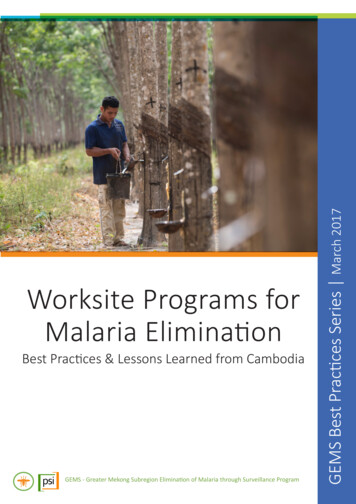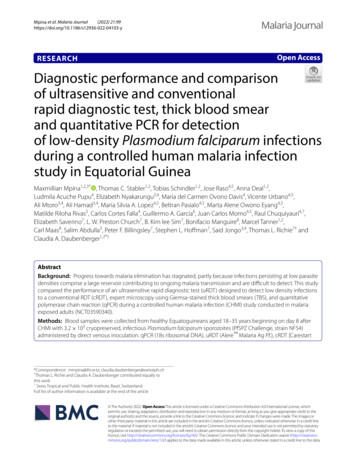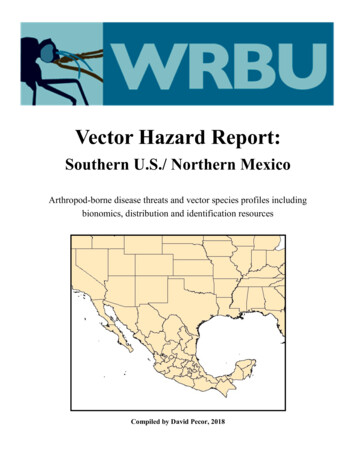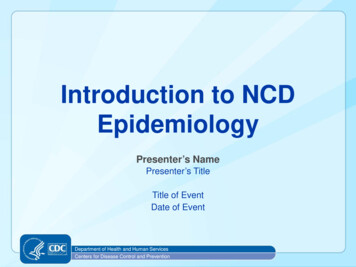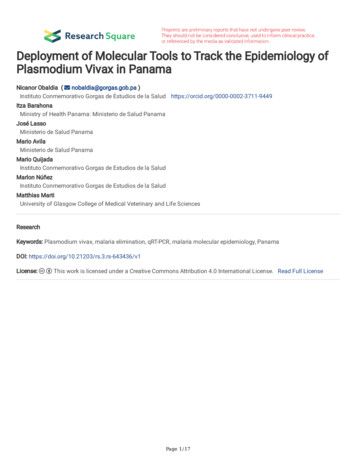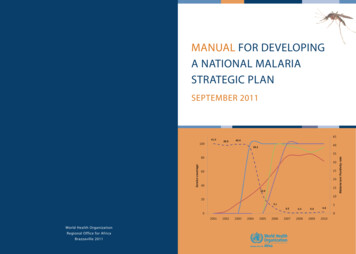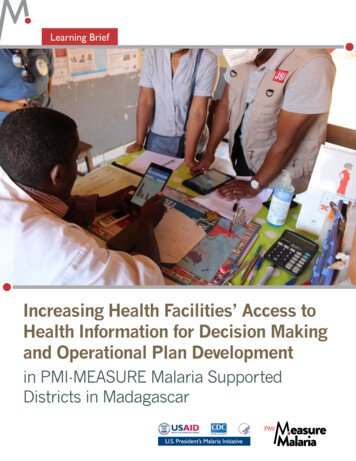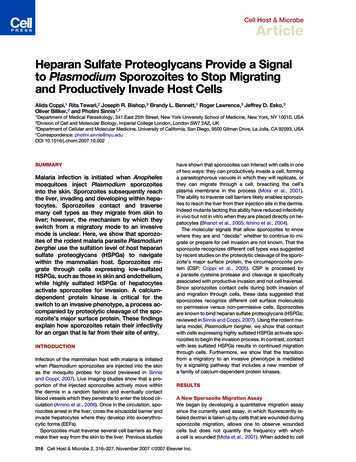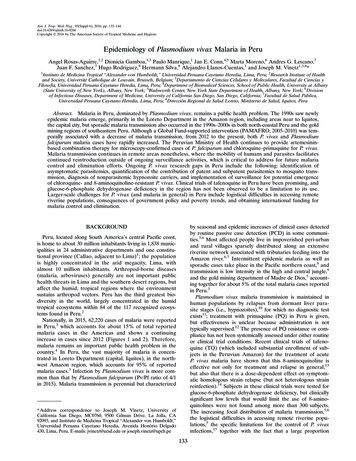
Transcription
Am. J. Trop. Med. Hyg., 95(Suppl 6), 2016, pp. 133–144doi:10.4269/ajtmh.16-0268Copyright 2016 by The American Society of Tropical Medicine and HygieneEpidemiology of Plasmodium vivax Malaria in PeruAngel Rosas-Aguirre,1,2 Dionicia Gamboa,1,3 Paulo Manrique,1 Jan E. Conn,4,5 Marta Moreno,6 Andres G. Lescano,7Juan F. Sanchez,7 Hugo Rodriguez,8 Hermann Silva,8 Alejandro Llanos-Cuentas,1 and Joseph M. Vinetz1,3,6*Instituto de Medicina Tropical “Alexander von Humboldt,” Universidad Peruana Cayetano Heredia, Lima, Peru; 2Research Institute of Healthand Society, Université Catholique de Louvain, Brussels, Belgium; 3Departamento de Ciencias Celulares y Moleculares, Facultad de Ciencias yFilosofia, Universidad Peruana Cayetano Heredia, Lima, Peru; 4Department of Biomedical Sciences, School of Public Health, University at Albany(State University of New York), Albany, New York; 5Wadsworth Center, New York State Department of Health, Albany, New York; 6Divisionof Infectious Diseases, Department of Medicine, University of California San Diego, San Diego, California; 7Facultad de Salud Pública,Universidad Peruana Cayetano Heredia, Lima, Peru; 8Dirección Regional de Salud Loreto, Ministerio de Salud, Iquitos, Peru1Abstract. Malaria in Peru, dominated by Plasmodium vivax, remains a public health problem. The 1990s saw newlyepidemic malaria emerge, primarily in the Loreto Department in the Amazon region, including areas near to Iquitos,the capital city, but sporadic malaria transmission also occurred in the 1990s–2000s in both north-coastal Peru and the goldmining regions of southeastern Peru. Although a Global Fund-supported intervention (PAMAFRO, 2005–2010) was temporally associated with a decrease of malaria transmission, from 2012 to the present, both P. vivax and Plasmodiumfalciparum malaria cases have rapidly increased. The Peruvian Ministry of Health continues to provide artemesininbased combination therapy for microscopy-confirmed cases of P. falciparum and chloroquine–primaquine for P. vivax.Malaria transmission continues in remote areas nonetheless, where the mobility of humans and parasites facilitatescontinued reintroduction outside of ongoing surveillance activities, which is critical to address for future malariacontrol and elimination efforts. Ongoing P. vivax research gaps in Peru include the following: identification ofasymptomatic parasitemics, quantification of the contribution of patent and subpatent parasitemics to mosquito transmission, diagnosis of nonparasitemic hypnozoite carriers, and implementation of surveillance for potential emergenceof chloroquine- and 8-aminoquinoline-resistant P. vivax. Clinical trials of tafenoquine in Peru have been promising, andglucose-6-phosphate dehydrogenase deficiency in the region has not been observed to be a limitation to its use.Larger-scale challenges for P. vivax (and malaria in general) in Peru include logistical difficulties in accessing remoteriverine populations, consequences of government policy and poverty trends, and obtaining international funding formalaria control and elimination.BACKGROUNDby seasonal and epidemic increases of clinical cases detectedby routine passive case detection (PCD) in some communities.5,6 Most affected people live in impoverished peri-urbanand rural villages sparsely distributed along an extensiveriverine network associated with tributaries feeding into theAmazon river.6,7 Intermittent epidemic malaria as well assporadic cases take place in the Pacific northern coast,8 andtransmission is low intensity in the high and central jungle,9and the gold mining department of Madre de Dios,5 accounting together for about 5% of the total malaria cases reportedin Peru.3Plasmodium vivax malaria transmission is maintained inhuman populations by relapses from dormant liver parasite stages (i.e., hypnozoites),10 for which no diagnostic testexists11; treatment with primaquine (PQ) in Peru is given,but effectiveness is unclear because administration is nottypically supervised.12 The presence of PQ resistance or compliance has not been systemically assessed under either routineor clinical trial conditions. Recent clinical trials of tafenoquine (TQ) (which included substantial enrollment of subjects in the Peruvian Amazon) for the treatment of acuteP. vivax malaria have shown that this 8-aminoquinoline iseffective not only for treatment and relapse in general,13but also that there is a dose-dependent effect on symptomatic homologous strain relapse (but not heterologous strainreinfection).14 Subjects in these clinical trials were tested forglucose-6-phosphate dehydrogenase deficiency, but clinicallysignificant low levels that would limit the use of 8-aminoquinolines were not found among more than 300 subjects.The increasing focal distribution of malaria transmission,5,6the logistical difficulties in accessing remote riverine populations,5 the specific limitations for the control of P. vivaxinfections,15 together with the fact that a large proportionPeru, located along South America’s central Pacific coast,is home to about 30 million inhabitants living in 1,838 municipalities in 24 administrative departments and one constitutional province (Callao, adjacent to Lima)1; the populationis highly concentrated in the arid megacity, Lima, withalmost 10 million inhabitants. Arthropod-borne diseases(malaria, arboviruses) generally are not important publichealth threats in Lima and the southern desert regions, butaffect the humid, tropical regions where the environmentsustains arthropod vectors. Peru has the third greatest biodiversity in the world, largely concentrated in the humidtropical ecosystems within 84 of the 117 recognized ecosystems found in Peru.2Nationally, in 2015, 62,220 cases of malaria were reportedin Peru,3 which accounts for about 15% of total reportedmalaria cases in the Americas and shows a continuingincrease in cases since 2012 (Figures 1 and 2). Therefore,malaria remains an important public health problem in thecountry.4 In Peru, the vast majority of malaria is concentrated in Loreto Department (capital, Iquitos), in the northwest Amazon region, which accounts for 95% of reportedmalaria cases.3 Infection by Plasmodium vivax is more common than that by Plasmodium falciparum (Pv/Pf ratio of 4/1in 2015). Malaria transmission is perennial but characterized*Address correspondence to Joseph M. Vinetz, University ofCalifornia San Diego, MC0760, 9500 Gilman Drive, La Jolla, CA92093, and Instituto de Medicina Tropical “Alexander von Humboldt,”Universidad Peruana Cayetano Heredia, Avenida Honório Delgado430, Lima, Peru. E-mails: jvinetz@ucsd.edu or joseph.vinetz@upch.pe133
134ROSAS-AGUIRRE AND OTHERSFIGURE 1. Historical trends of reported malaria incidence in Peru: 1940–2015. Source: Peruvian Ministry of Health.of those infections are asymptomatic and not detected bystandard diagnostic methods such as light microscopy(LM),5,6,16,17 pose major challenges to the Peruvian nationalmalaria control program (NMCP).Despite the increasing research conducted in Peru overthe past decade on P. vivax malaria epidemiology,17–21 diagnostics,22,23 treatment,12,13,24 vector biology,25–28 and molecular genetics,29–31 several knowledge gaps still need to beaddressed to support the Peruvian NMCP, so that malariatransmission hotspots can be readily identified and that theNMCP can more effectively implement strategies that target such areas with effective interventions.32 In this review,the trends in P. vivax incidence are described in relation tomajor control efforts implemented in Peru over the past70 years. The ecological context of P. vivax-endemic regionsin Peru is described, and key research findings related toP. vivax transmission and its control in the country areoutlined. Finally, the opportunities and challenges for notonly controlling but also sustaining such measures towardP. vivax elimination are discussed.FIGURE 2. Annual reported cases by Plasmodium species in Peru and Loreto: 1990–2015. Information on annual malaria cases was obtainedfrom the Regional Health Directorate of Loreto. Numbers in the timeline point out important events that influenced malaria incidence: 1) firstreport of Plasmodium falciparum in Loreto (1990); 2) first reports of chloroquine resistance (CQR) in P. falciparum (after 1994); 3) very strongEl Niño Southern Oscillation (ENSO) phenomenon (1996–1998); 4) implementation of new antimalarial treatment policy for P. falciparum andPlasmodium vivax malaria (2001–2004); and 5) Global Fund-PAMAFRO project (2005–2010).
EPIDEMIOLOGY OF PLASMODIUM VIVAX MALARIA IN PERUPERSISTENCE OF P. VIVAX TRANSMISSIONDESPITE CONVENTIONAL TEST AND TREATCONTROL EFFORTS IMPLEMENTED BYPUBLIC HEALTH AGENCIESEven though reported malaria cases were not systematically differentiated by Plasmodium species from the 1940s tothe 1990s,4 it is likely that P. vivax dominated. Long-standingpractices for gathering malaria case data are based on testand-treat models, which involve Ministry of Health information systems that passively gather microscopy-confirmedmalaria cases using paper registries. The data from these registries are reported and aggregated in a hierarchical fashionfrom health post to regional to national levels. Paper documentation is the practice at the local levels where the primarydata are gathered. After peaking with over 80,000 cases in1944,4 malaria dropped substantially in the following years;from 1960 to 1970, annual incidence rates remained belowone case per 1,000 inhabitants with the lowest levels registered in 1965, when only about 1,500 total cases werereported (Figure 1).33 These results have been due to theuse of dichloro-diphenyl-trichloroethane (DDT) in vectorcontrol campaigns after 1946, and to the shift of malaria control to a formal eradication strategy after 1957.4 The majorvector in the Amazon (i.e., Anopheles darlingi) was nearlyeliminated, and almost the entire coast, the inter-Andeanvalleys, and the Southern Amazon were determined to befree of malaria by 1970.34,35 However, the developmentof DDT resistance, as well as reduced political and publichealth interest resulting in decreased funding for controlmeasures and the redirection of malaria control responsibilities toward test and treat strategies according to medical(i.e., treating individuals) not public health (population-basedintervention) models, combined to halt progress in malariacontrol.34 It must be kept in mind that changes in governmental policies can lead to instability in the implementationof malaria control policies as well.In the 1980s, the Peruvian NMCP was not structured toenable elimination activities.34 Following international guidelines, DDT use was first halted in the Peruvian Amazon in1988, and then stopped across all of Peru. Predictably malariareemerged in the 1990s, following the reintroduction and laterspread of An. darlingi in the Amazon,33 as well as the simultaneous introduction of chloroquine (CQ)-resistant P. falciparumstrains (CQ) in the northern coast36 and CQ and sulfadoxine–pyrimethamine (SP) resistance in the Amazon region.37,38 Inassociation with severe weather changes linked to the El NiñoSouthern Oscillation (ENSO) climatologic phenomenon,4,39malaria increased dramatically reaching epidemic levelsbetween 1997 and 1999 (Figure 2). The highest annualmalaria incidence in the country was reported in 1998 withmore than 200,000 cases, of which about 60% and 40% weredue to P. vivax and P. falciparum, respectively (Pv/Pf ratio of1.5/1)(Figure 2). The Peruvian Amazon and the northerncoast were most affected,40 accounting for about 45% and40%, respectively, of the total malaria cases (approximately530,000 cases) during the 1997–1999 epidemic period.After the epidemic, malaria incidence in Peru droppedto 57,712 and 68,003 cases, respectively, in 2000 and 2001,followed by a slight increase and stabilization around80,000–85,000 cases between 2002 and 2005.41 The decreasing contribution of P. falciparum cases to the total malariacases during the period 2000–2005—as evidenced by an135increase of the Pv/Pf ratio from 2.5/1 to about 5/1—may bean early effect of the implementation of a new malariatreatment policy that introduced two different artemesininbased combination therapies (ACTs) as first-line treatmentsfor P. falciparum, that is, mefloquine–artesunate (AS) in theAmazon region, and AS–SP in the northern coast.37 WithP. vivax malaria, the radical treatment scheme including CQ(3 days) and PQ were also adjusted by shortening the PQ regimen from 14 to 7 days at increased daily dose (0.5 instead of0.25 mg/kg/day).37The new malaria treatment policy was implemented morequickly in the northern coast than in the Amazon, primarily because of better accessibility to malaria-endemic areas(i.e., peri-urban communities) which facilitated training andsupervision of the local health facilities and staff.42 Test-andtreat strategies—PCD of symptomatic subjects with treatmentonly of confirmed malaria infections with ACT—together withimplementation of community-based environmental management strategies to control the predominant vector Anophelesalbimanus (such as the shift of rice cultivation patterns) probably contributed to the steady decline in malaria incidenceobserved in the northern coast from the early 2000s.8,42In the Amazon region, the new treatment policy tooklonger to implement. After 2005, the implementation process was driven by the Global Fund’s Malaria Project“PAMAFRO”43 by increasing accessibility and quality ofmicroscopy-based diagnosis, ensuring availability of effectiveantimalarials, and periodic training and supervision of localhealth workers, even in the most remote endemic areas. Thiswork did not involve intervening to reduce mosquito breeding sites in communities as an alternative to the use of insecticide spraying because of lack of knowledge of where suchsites lay. PAMAFRO was simultaneously applied at theborder areas of Venezuela, Colombia, Ecuador, and Perubetween October 2005 and September 2010, with commoncontrol strategies, including early diagnosis and treatment,active case detection (ACD) interventions in communitiesof high malaria risk (as determined by a set number of cases,and only carried out either under this PAMAFRO programor research conditions), mass distribution of long-lastinginsecticide-treated bed nets, community participation (localhealth worker involvement and empowerment to implementcampaign), and intensified health education and promotioncampaigns.44–46 During this period, malaria declined in Perufrom 87,805 reported clinical cases in 2005 to 29,339 and23,060 cases in 2010 and 2011, respectively.41,42 Comparatively, the percentage of reduction in reported cases washigher for P. falciparum (85%) than for P. vivax (63%),thus keeping the increasing trend of the Pv/Pf ratio untilreaching its maximum (11.8/1) in 2010 (Figure 3). Afteralmost 40 years and for the second time in the known historyof malaria in Peru, the malaria incidence rate was less than1 case/1,000 inhabitants in those 2 consecutive years (2010and 2011) (Figure 1). The significant reduction in malariaincidence from 1998 to 2013 led to important changes in themalaria risk map in Peru; with each subsequent year, lowtransmission areas predominated more and more over highand moderate-transmission areas (Figure 3). The quantitativecontributions of PAMAFRO, sociopolitical, public healthpractices and policies, and climate-related changes to thesemalaria risk map changes are not known, but remain to beexplored in future work.
136ROSAS-AGUIRRE AND OTHERSFIGURE 3. Malaria risk map of Peru based on annual incidence rates 1998–2013 (annual parasitological index [API]). Source: Peruvian Ministry of Health.However, there have been alarming developments since2011. Since then, the number of malaria cases again began torise (Figures 2 and 3), with the total number of reportedP. vivax and P. falciparum cases increasing from 20,421 to49,745 and from 2,639 to 12,475 cases, respectively, from2011 to 2015.3 One leading hypothesis to explain the rapidresurgence of malaria after 2011 is that the Peruvian NMCPwas politically and financially limited so that it could not keepup with the intense control interventions in the Amazon afterthe PAMAFRO project ended.6,42 Because of such a rapidresurgence, other factors must have contributed includingweather changes (i.e., increased rain, increased river heightrelated to Andean snow melt related to climate change, aswell as social and political disorder in Iquitos in recent years.Funds were reallocated to more pressing public health issuesin the region (particularly dengue), because it was assumedthat malaria was “under control,” combined with unusuallyheavy rains after 2011, which damage and flooding to manyrural communities located along the Amazon river and all itstributaries, further worsened the situation.42 Political andfinancial commitment from the Peruvian government to combat this malaria resurgence has increased since 2015, allowingfor a wider deployment of ACD interventions in the highestrisk communities. However, the impact of these efforts mightbe limited if strategies are not adapted to the specific localmalaria epidemiology, and, importantly, commitment is notsustained. More attention to longer-term investment in elimination strategies with development and deployment of newmalaria intervention tools will also be required.PERUVIAN P. VIVAX-ENDEMIC REGIONSAbout half the total population of Peru is potentiallyexposed to malaria or lives in areas with ecological factorsfavorable to transmission,42 both of which are found in thenorthern and southern Amazon region, and in the Pacificnorthern coast (Table 1).The northern Amazon region comprises predominantly theLoreto Department, located in the northeast of Peru andcovering almost 30% of total territory in Peru and most ofthe Amazon region. Loreto is home to about 1 millioninhabitants.1 Its climate is warm and humid with a heavyrainy season from November to May and a mild rainy seasonfrom June to October.33 Malaria transmission is perennial,peaking between February and July,47 but with some variations across districts. The highly anthropophilic mosquito,An. darlingi, is the primary malaria vector, and a recentreport showed a trend in this vector for increasing outdoorbiting compared with previous reports of near-equal indoorand outdoor biting.28 Plasmodium vivax and P. falciparuminfections occur at a ratio of 4/1 mainly in people living inopen or semiclosed wooden houses located in rural andremote villages along the main Amazon river and its tributaries.7 All age groups are at risk of infection, though adultsmore so than children.Despite the fact that Loreto has been considered to behypoendemic for malaria transmission,16 routine surveillancedata and epidemiological studies suggest that malaria transmission in the region is highly heterogeneous, with someareas in relatively remote Amazonia having entomologicalinoculation rates (EIRs) rivaling those found in holoendemicregions of Africa.19 More than 80% of the total malaria clinical cases detected by PCD in Loreto are concentrated amongonly 10–20% of the total communities of the department.6Moreover, cross-sectional studies using LM for malaria diagnosis have also showed that malaria parasite prevalencevaried considerably across communities around Iquitos (capital of Loreto),16,47 and those differences remained or even
137EPIDEMIOLOGY OF PLASMODIUM VIVAX MALARIA IN PERUTABLE 1Characteristics of malaria transmission in Peruvian endemic regionsCharacteristicsPeriod of transmissionEnvironmental conditionsOther ecological conditionsVectorParasiteRisk areasHouse characteristicsEconomical activitiesAccessibility to health servicesNorthern AmazonPerennial transmission withmarked seasonalityTropical rainforest, heavy rains(November–April)DeforestationAnopheles darlingi,Anopheles benarrochiPlasmodium vivax (80%),Plasmodium falciparum (20%)Rural, peri-urbanOpen houses without walls orrudimentary wallsSubsistence-scale agriculture,logging, fishing, huntingLimitedSouthern AmazonNorthern coastSeasonal, stochasticSeasonal transmissionTropical rainforest, heavy rains(December–April)DeforestationAn. darlingi, An. benarrochiDry desert area, rainfall(December–March) influencedby ENSORice farmingAnopheles albimanusP. vivaxP. vivax (99%), P. falciparum ( 1%)RuralOpen houses without wallsor rudimentary wallsIllegal gold miningUrban, peri-urbanClosed houses with completed wallsLimitedAccessibleCommerce, fishing, agricultureENSO El Niño Southern Oscillation.increased when using more sensitive diagnostic tests.16,48Indeed, the use of polymerase chain reaction (PCR) in epidemiological studies has shown that an important proportionof the total infections are asymptomatic and with low andsubmicroscopic (subpatent) parasite densities.5,6,16,48 Similarly,entomological studies have also shown evidence for transmission heterogeneity by finding a wide variation of EIR estimatesat the microgeographical level in riverine campsites about50 km of Iquitos and along the only paved highway in Loreto(the Iquitos–Nauta road).19,26,49 Among the potential explanations for the spatial heterogeneity of malaria are ecologicalfactors that facilitate mosquito breeding and resting sites areassociated with deforestation, natural and man-made waterbodies (e.g., fish ponds), and surrounding secondary vegetation are among the potential explanations for the spatialheterogeneity of malaria. In addition to vector-related ecological factors, human socioeconomic differences such aspoorer housing conditions (open or semiclosed houses)50and outdoor economic activities (such as farming, logging,or fishing) and travel along riverine routes among endemicsites of transmission likely play an important role in themaintenance of malaria transmission, often with unexpected,stochastic patterns.7The southeastern jungle of the Peruvian Amazon region,that is, the Madre de Dios Department, has long experienced intermittently epidemic and sporadic malaria, virtually all of which is due to P. vivax.51 The primary driverof malaria in this region is illegal gold mining, with attendant ecological, political, and socioeconomic change. Conventional wisdom is that malaria is repeatedly reintroducedinto the region by migrants who acquired infection inendemic areas, so that small outbreaks occur, then disappear for unknown reasons. The analysis of PCD databetween 2001 and 2012 (J. F. Sanchez, J. M. Vinetz, A. G.Lescano, unpublished data), showed that of 203,773 febrilecases, 30,811 (15%) were confirmed cases of malaria, alldue to P. vivax. The 10 P. falciparum cases identified during this period were likely imported from Brazil. Healthfacilities located in areas of intense illegal gold miningreported 30-fold more malaria cases than those in nonminingareas (ratio 31.54, 95% confidence interval [CI] 19.28,51.60); health facilities located more than 1 km from theInterOceanic Highway reported significantly more casesthan those within this distance (ratio 16.20, 95% CI 8.25, 31.80).Transmission of malaria in Madre de Dios is unstable andgeographically heterogeneous. The primary malaria vector isAn. darlingi, but to date it has proven difficult to identifybreeding sites of this mosquito species within environmentalcontamination and degradation related to human settlements and mining-related chemical discharges in the malariaaffected areas. Anopheles (Nyssorhynchus) benarrochi B andAnopheles (Nyssorhynchus) rangeli were also found amonganopheline specimens obtained and analyzed in 2011 byhuman landing catch, Shannon and CDC traps (Centers forDisease Control and Prevention, Atlanta, GA) from themalaria endemic localities of Santa Rosa and San Pedro inMadre de Dios Department, Peru; neither of these potentialsecondary vectors were found to be positive for Plasmodiuminfection by cytochromb b (CytB)-PCR, although the samplesize was relatively small.52 Research findings in Madre deDios highlight the unpredictable nature of malaria transmission in areas of Peru where public health policies are difficultto implement, and only control measures based on PCDhave been carried out. These observations underscore theimportance of continued stochastic reintroductions of malaria,that timely, surveillance-based interventions are needed tocontrol malaria in neglected and politically challenging regions,and the need for new tools for monitoring and predictingnewly emerging malaria in areas where anophelism remains,for example, in illegal gold mining camps.The northwestern coast, which includes Tumbes, Piura,Lambayeque, and La Libertad departments, has historicallybeen the second most important region for malaria transmission after the Amazon rainforest.4 This region is characterized by the presence of coastal valleys conducive topropagation of anopheline vectors (primarily An. albimanus)as well as by human migration for labor-intense agriculturalactivities.53 The region typically has hot and humid summerswith moderate rains from December to March and winterseasons from April to November with cool and dry days.However, this seasonal climate pattern has changed in thepast by the ENSO phenomenon,39 with torrential rains andstrong winds causing flooding and landslides, events that
138ROSAS-AGUIRRE AND OTHERShave been associated with malaria outbreaks (e.g., malariaepidemic in 1997–1998).Malaria has significantly declined in north-coastal Peruover the past decade.3 Currently, reported malaria casesare exclusively P. vivax and concentrated in a few localitiesof Piura and Tumbes.3 Transmission occurs in epidemic andsporadic patterns between February and June, the monthsof highest density of the main vector, An. albimanus.53 Themost affected people live in peri-urban localities in closeproximity to irrigated fields and irrigation canals whichenable anopheline mosquitoes to propagate and survive.20,53Although houses in those localities have complete walls(closed houses), they are mainly made of poor materials thatdo not exclude mosquitoes.PLASMODIUM VIVAX MALARIA IN PERURecent years have seen the increased recognition thatP. vivax malaria may present as a severe disease accordingto newly published World Health Organization (WHO)criteria.54–57 Severe malaria has been observed in Peru,both in the northern coast58 and related to travelers whopresented in Lima (a nonendemic area) with severe malariadue to P. vivax (and P. falciparum) acquired in known malarious regions.9 Severe vivax malaria in Peru appears tohave similar characteristics compared with elsewhere inAmazonia,59 but appears to be less common in Amazoniathan in India.60 In the Loreto region, more than two-thirdsof cases of severe malaria arriving at referral hospitalsare due to P. vivax and belong to Group I of the new WHOclassification, meaning that, because of the possibility ofP. falciparum coinfection (without parasitological proof),61such cases must be treated with intravenous AS in additionto standard P. vivax therapy. Although such cases presentwith profound prostration, the level of consciousness is generally preserved. Consistent with this observation, recentautopsy information from Brazil indicates that P. vivax is notfound in brain in patients with coma.62 Limitations of studies of severe vivax malaria include lack of investigationof comorbid illness or coinfection, and their retrospectivenature. Further, mechanisms of severe P. vivax malaria pathogenesis, whether from the host response or parasite virulence mechanisms, remain to be explored, particularly withregard to pulmonary and multiorgan failure syndromes.DETECTION OF P. VIVAX INFECTIONIn Peru, governmental policy dictates that LM remainsthe main approach to diagnose acute malaria and guideappropriate treatment.63 The Peruvian Ministry of Healthhas established a strong National Network of Public Healthlaboratories classified into four levels: local, intermediate,regional, and national level. This network is designated toperform both diagnosis and quality control of thick bloodsmears,64 according to international norms published bythe WHO.Microscopy is routinely performed on samples from allfebrile cases who present to health facilities and/or hospitals,local and intermediate laboratory levels, respectively, withsigns and symptoms suggestive of acute malaria. In 2015 inLoreto, 321,723 thick blood smears were read at healthfacilities as part of this PCD, and 48,987 thick blood smearswere read as part of reactive ACD, from collaterals, individuals who live in close proximity to passively detected cases(Directorate of Public Health Reference Laboratory, Iquitos,Peru, personal communication). After PAMAFRO endedin 2010, ACD activities carried out by the Regional HealthOffice (DIRESA) substantially declined in the region.Directly related to current resurgent P. vivax andP. falciparum malaria in the Loreto Department of Peru,access to timely and effective malaria diagnostics remains achallenge in the region. During the PAMAFRO project,the coverage of the National Network of Public Health laboratories increased with purchase and deployment of newmicroscopes combined with intensive training of healthpersonnel.46 There are still areas where, because of logistical challenges, other diagnostic tools should be used, suchas point-of-care deployable rapid diagnostic tests (RDTs).RDTs were introduced in Peru in 1998 as an alternativeto microscopy in remote areas of the Peruvian Amazon.However, the clinical performance of RDTs has not beenconsistently useful in Peru. RDTs were last reported to beused in Loreto for confirmatory diagnosis in 2006, withinthe PAMAFRO project, with an unacceptable performance(sensitivity of 77% and 54% for non-falciparum andP. falciparum, respectively); results were observed to be evenworse when parasitemia was less than 100/μL on LM65 Inaddition, many false-negative RDTs related to histidineri
lations,5 the specific limitations for the control of P. vivax infections,15 together with the fact that a large proportion *Address correspondence to Joseph M. Vinetz, University of California San Diego, MC0760, 9500 Gilman Drive, La Jolla, CA 92093, and Instituto de Medicina Tropical "Alexander von Humboldt,"

